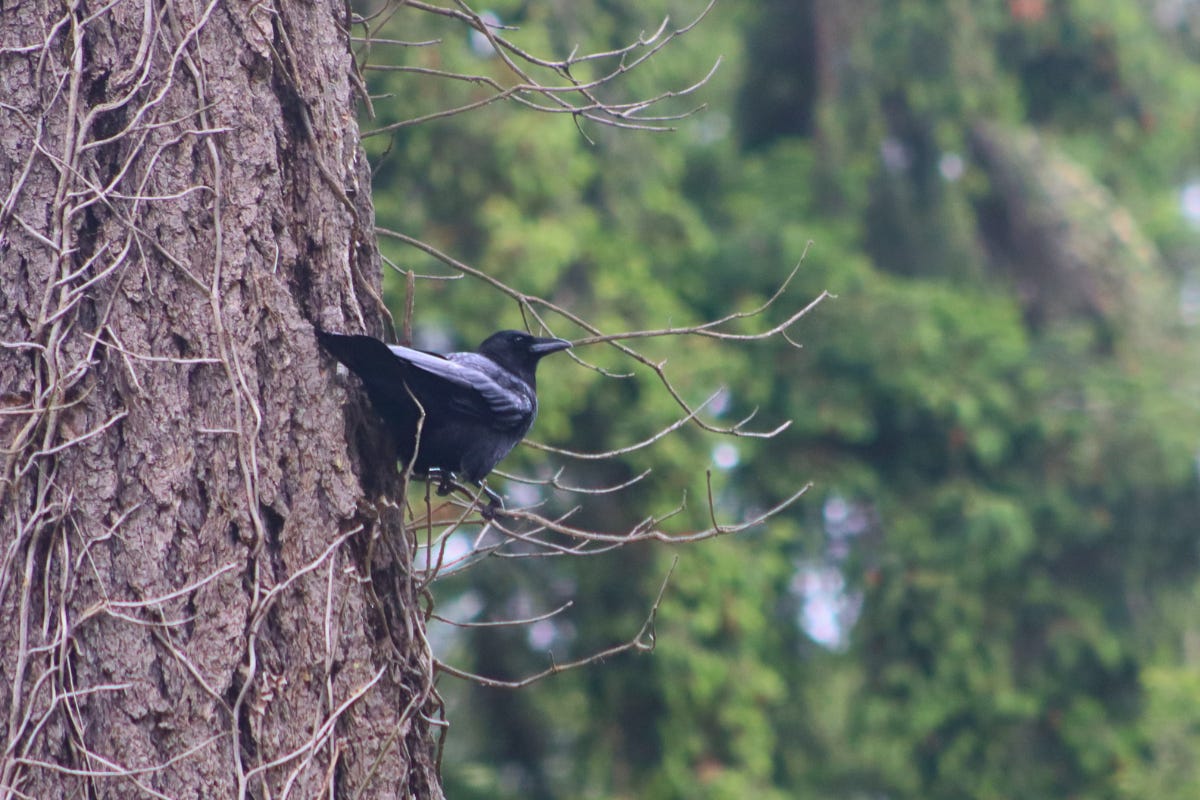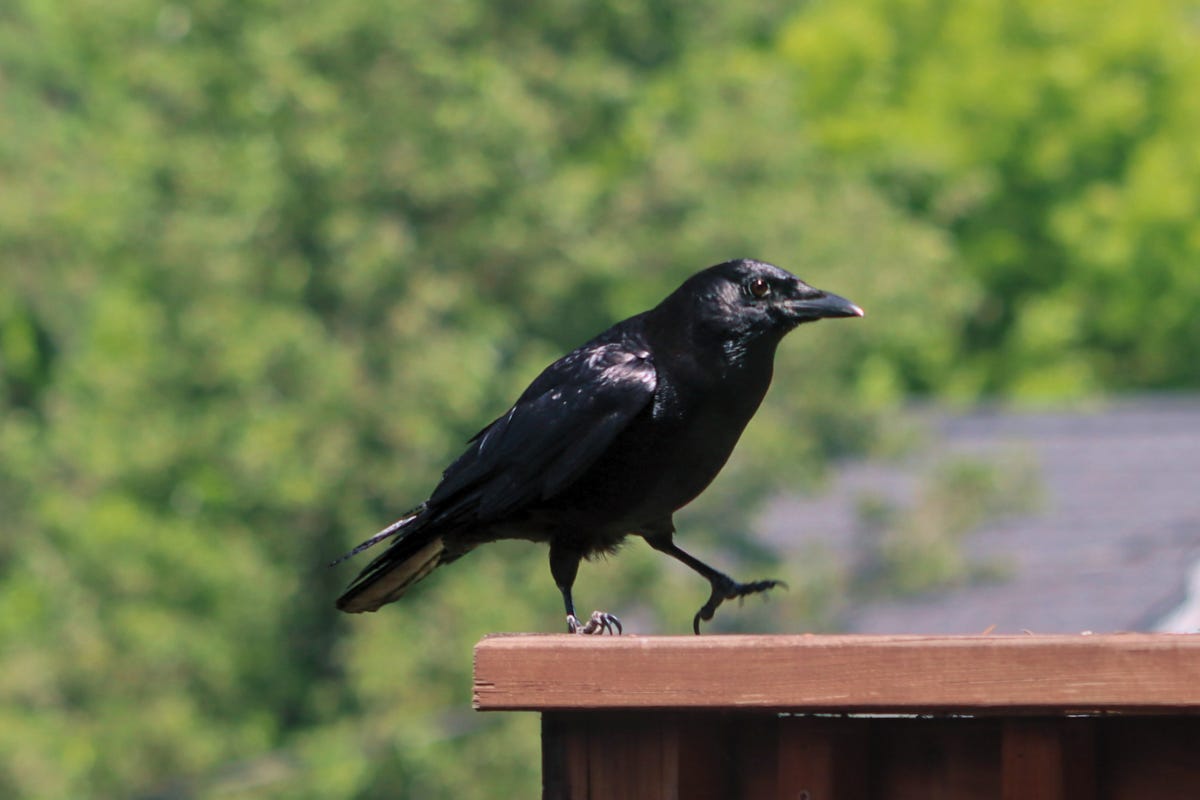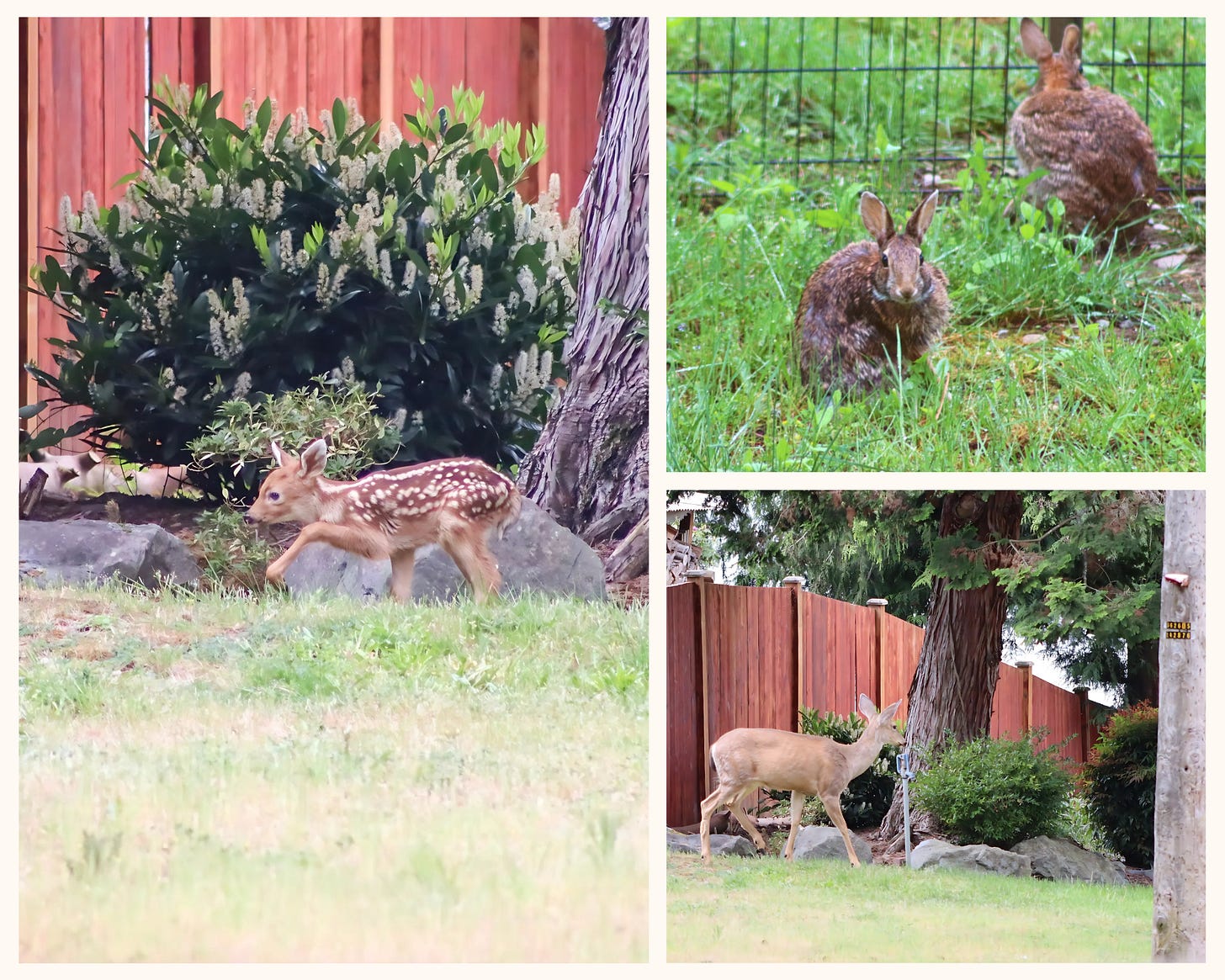When Crows Become Teachers
Discover how two backyard crows, Pistachio and Lady Bird, unexpectedly taught me profound lessons in empathy, connection, and reclaiming my values as a homeowner sharing space with nature.
It all started over coffee, as the best things often do. A conversation, in which I was likely half-asleep, nodded, and agreed to purchase all the goods necessary for my daughter to befriend a local murder.
While at the time, I knew zilch about crows – and all that comes with entering a diplomatic treaty with a local corvid delegation – I learned quickly. Our murder of two, affectionately known as Pistachio and Lady Bird, has since declared us all friends, winning over our hearts and nudging our introverted household a little closer to extroversion (it's a stretch, I get it).
This curated friendship began, as all good friendships should, out of consistent, high-value food offerings. We served a rotating selection of unsalted peanuts and pistachios, the occasional spoonful of high-quality cat food, the finest charcuterie boards (mealworms and all), and during nesting season, even premium, locally sourced dog fur – a true luxury for any nest-building corvid.
For weeks, they accepted our gifts with a healthy dose of suspicion. They’d watch from a high branch, wait until we were safely behind the glass door, then swoop down, snatch a treat, and flee. For many months, it was a transactional exchange, not quite a relationship.
But we were patient. We learned their habits, and took to Google for the rest.

I learned these are American Crows (Corvus brachyrhynchos), the most common crow here in Washington state and, as it turns out, one of the more intelligent birds. For your daily dose of fascinating bird stats, they apparently boast a brain-to-body size ratio comparable to that of a toddler. This suddenly made their cautious, calculating approach to the weird lady leaving nuts on her deck – and all her strange attempts to whistle, which ultimately failed, sounding more like an injured, out-of-breath Bandersnatch – make perfect sense. Their intelligence also explains their remarkable problem-solving skills and their ability to remember human faces, both good and bad.
At a pace best suited for birds, a fragile trust began to form. One day, they stopped fleeing. They’d land on the railing while we were all still visible, tilting their heads in curiosity. Eventually, they deemed our other household beasts – the cats and dogs who sit at the window like it's a movie theater – to be an acceptable, quiet audience.
And then, a breakthrough.

One morning, after Pistachio had collected his daily toll, he returned. He hopped onto the railing and delicately placed a fat, juicy worm exactly where we had left his meal. Was this a trade? An acknowledgment? A gift of reciprocal friendship? We'll never know for sure, but for us, it cemented our decision to lean into friendship. Although, just as we discovered our newfound treasure, a jealous Steller’s Jay dive-bombed the railing and stole the worm. Seeing as worms are not our normal delicacy, we claimed it as a victory nonetheless.
Now, with months under our belt, our relationship has evolved. Pistachio and Lady Bird have taken to yelling at me when I walk outside without their tribute. They fearlessly sit on the telephone wire, staring down at us while we work in the yard, swooping down to snag whatever yummy goodness we unearth as we continue to transform our backyard into a wildlife refuge.
And while I cannot be certain, I am almost positive that Pistachio has begun to bark at me – mimicking our corgis when it’s dinner time.

All in all, this relationship has been one that the entire household has come to enjoy – tiny, miniature-legged beasts and all. While it has added a little extra responsibility to our day, another chore and set of beings who require food, these corvid companions have also brought us closer to something we were missing.
An empathy that went beyond our humanness. Pistachio and Lady Bird opened my eyes to something that has completely shifted how we conduct ourselves and our responsibilities as homeowners sharing space with a vibrant ecosystem.
What I once saw as a landscape that was in my way, difficult to manage, and ideally wanted to rid myself of – has come to be a sanctuary in the making (ideally!). Instead of wanting to cut down the 15+ Douglas Firs surrounding my home, we had them assessed, removing only those very few that were diseased. We took to learning way more about trees than I ever thought I would know, all to ensure our corvid friends, along with other local wildlife, are not further disrupted by our presence.
We’ve also begun creating a completely native yard that includes gardens for wildlife to enjoy, building an ecosystem that crows, bunnies, deer, and all our other furry and feathery friends will love. This shift has not only benefited the local fauna but has also reduced our water usage and maintenance, proving that sometimes, doing right by nature also makes life simpler for us (duh).
Had you told me a year ago that I would have made crow friends, and they would leave me questioning my values as a human being in a shared world, I would have thought you wildly out of your mind. But here I am, immersed in this unexpected diplomacy. I’ve learned so much about the intricate wildlife in my little space and am working diligently to preserve it – from our native PNW plants to our feathery friends, and all the bugs, butterflies, and bees that come our way.

Thinking of Befriending Your Own Murder?
While I have been obsessed with birds for the past six years, spotting them in the wild and getting a photo is one thing. Making friends? Well, that’s been quite another. This whole interaction has been a beautiful reminder that connection is built on patience, attention, and of course, empathy and compassion.
If you're looking to start your own diplomatic relations, here’s what our negotiations have taught us:
Be Consistent & Offer the Good Stuff: Offer high-value treats (like unsalted peanuts, eggs, or even unsalted, unbuttered popcorn) at the same time and place on a specific cadence to help build a routine. Crows are masters of pattern recognition, but trust takes time. Don’t get discouraged if they ignore you for weeks or months. They’re watching. They’re learning your face. Studies have shown that crows not only recognize individual human faces but can also hold grudges, so you want to be known as the "Safe Snack Folk," not a potential threat.
Give Them Space (and Don't Overdo It): The most important part of building trust is letting them come to you. Leave the food and walk away. Don’t stare. Let them see you as a safe, non-threatening source of delicious things. Crucially, this isn't about becoming their primary food source. Overfeeding can make them dependent, which is harmful to any wild animal and can also lead to increased nuisance behavior. We offer a small handful of treats as a friendly gesture, not an all-you-can-eat buffet. Now that they know us, we have lessened our cadence to ensure they do not become dependent.
Be a Mindful Observer (and a Good Neighbor): Pay attention to the world you're stepping into. We didn’t just jump into this idea. We noticed our farmer neighbor was always yelling and shooting fireworks at 5 a.m. to scare the crows away; since we have intervened, he has since stopped. Our offerings seem to have created a truce that benefits everyone's morning peace. However, we also have to be careful that our hobby doesn't mess up an ecosystem we're not truly a part of. We witnessed our gift of a worm get stolen by a Steller's Jay, a stark reminder that we're interacting with a complex food web. The goal is to be a respectful participant, not an accidental disruptor.
Speak Their Language (or at Least Try): Find a consistent sound to associate with your arrival. It doesn't have to be a perfect crow call (my attempts sounded like an injured Bandersnatch and didn’t scare them off). A simple, quiet whistle or a couple of clicks of the tongue every time you leave food will create a powerful association. Eventually, you may even find they start making a specific sound just for you – like Pistachio's newfound 'bark.'
Appreciate Their Weird Gifts: The worm was just the beginning. The world of crow gift-giving is a well-documented and fascinating phenomenon. If your crow friends start leaving you things, they might not be what you expect. Be prepared to graciously accept shiny pebbles, bottle caps, interesting sticks, or small bones. This behavior is a clear sign of reciprocity – a crow's way of acknowledging a relationship and sharing something of value with a trusted ally.

plant a little chaos in your inbox






